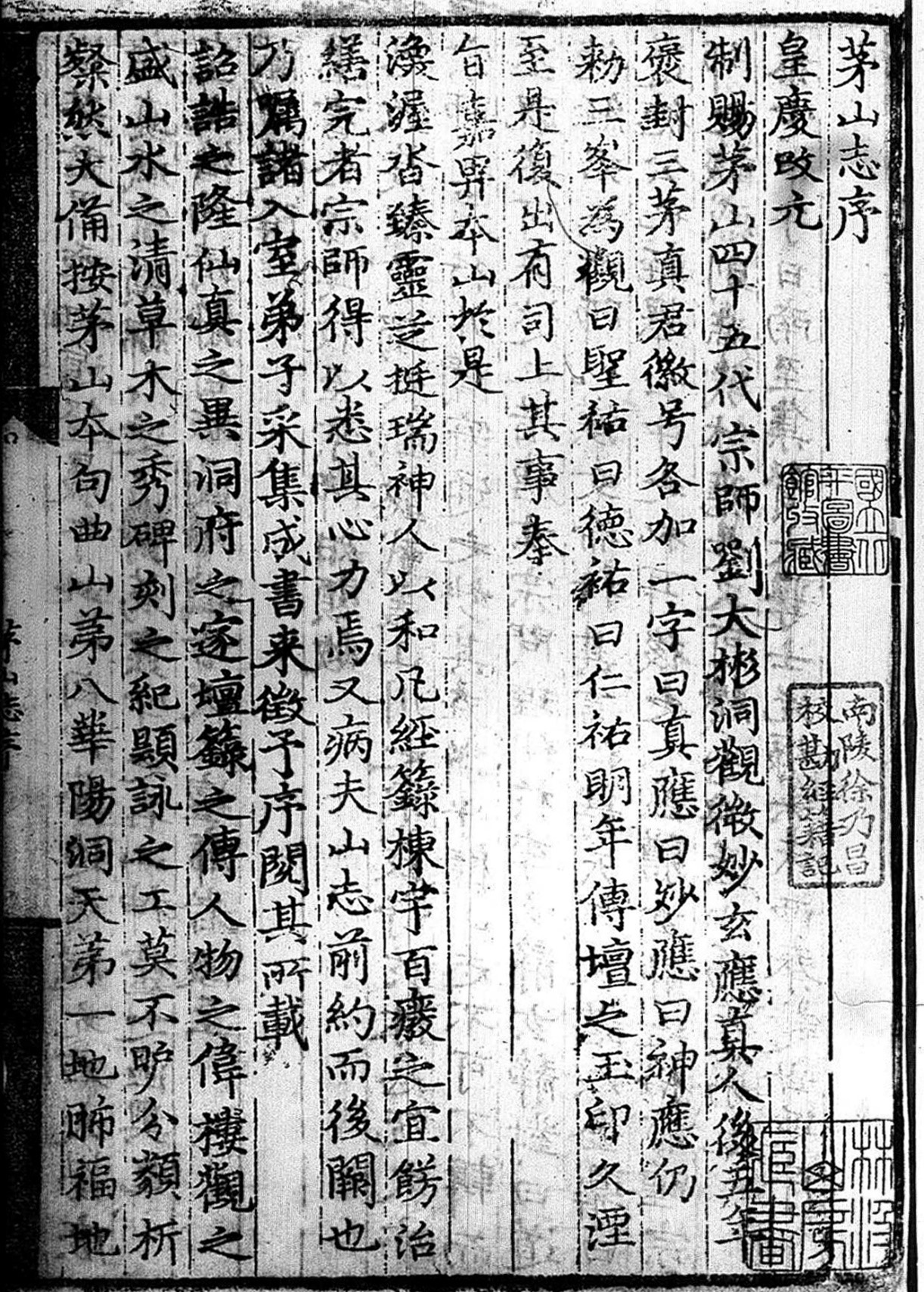茅山志 - NLC1
茅山志 Mao shan zhi |
| 別名 Other Titles: |
| 有關人物 Associated Persons: 劉大彬, 張雨
出版地區 Place(s) of Publication: 茅山 版式 Format: 木刻版 出版者 Publisher(s): 元符萬寧宮 出版年 Publication Date: 1423 載於 Located In: National Library of China, Beijing - NLC |
| Cite as 引用為: "CRTA 茅山志 - NLC1" |
Maoshan zhi, in its original form, is a 15-fascicle (juan) gazetteer about Maoshan 茅山 and the Daoist temples on it near Nanjing 南京, the original site of the Shangqing 上清 revelations. Only the portions of the original edition (the front matters, juan 1-2, 8-11, 13) survive. But a reprint of this edition during the Yongle reign (1403-1424; hereafter Yongle ed.) whose preface is dated 1423 preserves the original contents and format except the inclusion of four additional Ming poems in juan 15.
別名 Other Titles
出版地區 Place(s) of Publication
出版年 Publication Date(s)
The date of the completion of the compilation under Liu Dabin 劉大彬 (fl. 1317–28) is 1330, and Zhang Yu 張雨 (1277–1348) transcribed and printed it also in 1330 or slightly later. The Yongle edition was printed during the Yongle reign (1403-24) whose preface is dated 1423. One copy of the Yongle edition is preserved at the National Library of China, Beijing, whose digital version is available online now, while another at the National Palace Museum, Taipei.
有關人物 Associated Person(s)
No Additional Information
內容 Contents
- 封面 Title Page (not extant)
- 茅山志序(趙世延序)[序1a-b]
- No title [tentatively titled 茅山志序]茅山志序(吳全節序)[序2a-b]
- 茅山志敘錄(劉大彬序)[敘錄1a-2b]
- 茅山志卷首
- 目錄[目1a-2b]
- 誥副墨第一篇上卷之第一
- 漢詔誥[頁1a-2b]
- 齊梁詔誥[頁3a-8a]
- 唐詔誥[頁9a-19b]
- 誥副墨第一篇下卷之第二
- 宋詔誥[頁1a-22a]
- 大元詔誥[頁23a-27a]
- 三神紀第二篇卷之第三
- 茅君真胄[頁1a-11a]
- 括神區第三篇卷之第四
- 山(岡隴附)[頁3a-6b]
- 洞(岩穴附)[頁7a-9b]
- 水[頁10a-12b] (listed before the section of “洞” in the table of contents)
- 壇石橋亭[頁13a-14b] (The section head is written “石磴橋亭” in the table of contents)
- 稽古蹟第四篇卷之第五
- 壇井池臺[頁1a-4b] (There is no section head in the text of the book per se.)
- 道山冊第五篇卷之第六
- 道經[頁1a-5a] (There is no section head in the text of the book per se.)
- 圖籙[頁5b-6b] (There is no section head in the text of the book per se.)
- 道書[頁7a-10b] (There is no section head in the text of the book per se.)
- 上清品第六篇卷之第七
- 聖師七傳[頁1a-3a] (The section head is written “上清經籙聖師七傳真系之譜” in the text of the book per se.)
- 宗師四十五傳系代虚其左方[頁4a-26a] (There is no section head in the text of the book per se.)
- 仙曹署第七篇卷之第八
- 男真[頁1a-6a] (There is no section head in the text of the book per se.)
- 女仙[頁6a-7b] (There is no section head in the text of the book per se.)
- 茅山仙人[頁7b-10b] (There is no such a section head in the table of contents)
- 采真游第八篇卷之第九 [頁1a-14b]
- 高士 (There is no section head in the text of the book per se.)
- 女官 (There is no section head in the text of the book per se.)
- 樓觀部第九篇卷之第十
- 宮觀[頁1a-5b] (There is no section head in the text of the book per se.)
- 山房[頁6a-9a] (The section head is written “山房菴院” in the text of the book per se, thus combining the two sections.)
- 菴院 (There is no section head in the text of the book per se.)
- 靈植檢第十篇卷之十一
- 神芝奇藥[頁1a-3b]
- 名木異卉[頁4a-b]
- 錄金石十一篇上卷之十二
- 梁碑[頁1a-14a]
- 唐碑[頁15a-46b]
- 錄金石十一篇下卷之十三
- 宋碑[頁1a-30b]
- 大元碑[頁31a-36b]
- 金薤編十二篇上卷之十四
- 齊梁詩[頁1a-2b]
- 唐詩[頁3a-17b]
- 金薤編十二篇下卷之十五
- 宋詩[頁1a-8b]
- 大元詩[頁9a-23b]
- 續金薤編卷一[continues with 大元詩, 頁24a-b]
- 續金薤編卷二[continues with 大元詩, one folio page with n.p.]
- 續金薤編卷三[continues with 大元詩, one folio page with n.p.]
- 續金薤編卷四[one folio page with n.p.; four Ming poems]
- 雜著終[頁24a-28b] (The section head is written “雜著” in the text of the book per se)
序跋等 Prefaces and Postfaces
- 茅山志序(趙序)
- 泰丁甲子日南至(1324)
- 集賢大學士光祿大夫西秦趙世延序
- No title [tentatively titled 茅山志序](吳序)
- 泰丁丁卯春正月(1327)
- 特進上卿玄教大宗師吳全節序
- 茅山志敘錄(劉序)
- 大元天曆元年歲在戊辰十二月二日(1328)
- 嗣上清經籙四十五代宗師洞觀微妙玄應真人劉大彬序
- 後跋
- 上清傳真圖序
- 大元延佑柒年庚申歲九日(1320)
- 前翰林學士承旨榮祿大夫知制誥兼脩國史趙孟頫序
- 金華道士錢唐西湖隱真菴開山何道堅施梓
註疏 Commentary
[Richard G. Wang] When the Daozang 道藏 (Daoist Canon) known as the Da Ming daozang jing 大明道藏經, completed in 1445, included the Maoshan zhi in it, the Daozang divided the Maoshan zhi (DZ 304) into 33-fascicle (juan). Initially named Mount Gouqu (Gouqu shan 句曲山), Mount Mao (Maoshan 茅山) is located between Jurong 句容 and Jintan 金壇, south of Nanjing (Jiangsu) 江蘇省南京市. Since ancient times, Maoshan had its tradition of hermits cultivating there. The mountain was considered the site of the eighth Grotto-Heaven 第八洞天 and the first Blissful Land 第一福地. The mountain received its name due to its association with the three Mao brothers (Mao Ying 茅盈, Mao Zhong 茅衷, and Mao Gu 茅固), who alighted on its three peaks during the Han dynasty (202 BC–220 AD), practiced there and ascended as transcendents. Maoshan later served as the site of the Shangqing 上清 (Highest Clarity) revelations. Indeed, the mountain almost became synonymous with the Shangqing tradition, which originated there between the fourth and fifth centuries. During the Song dynasty (960–1279), Maoshan was home to a new set of revelations which, while rooted to some extent in the Shangqing tradition, are characterized by their emphasis on exorcism. At Maoshan, there were many Daoist temples, the most famous of which were the so-called “Three-Palaces and Five Abbeys” 三宮五觀. The Liu Dabin edition of the Maoshan zhi is the earliest extant, and the most valuable, gazetteer on the mountain, and one of the most important sources for the study of the Shangqing school and Maoshan, recording the genealogy of the Shangqing patriarchs, the historical changes of the temples, and the Daoist lineage there. Although only fragments of the original Yuan Liu Dabin edition have survived to this day, the Yongle edition as the earliest reprint of it retains the value, contents and format of the original Yuan edition.
參考文獻 Bibliography
- 卢仁龙,《<道藏>本<茅山志>研究》,《社会科学战线》,1992年第2期,第325-31页。
- 王崗,《明版全本<茅山志>與明代茅山正一道(代前言)》,《中國文哲研究通訊》第24卷第3期(2014),第1-56頁。
- 劉大彬編、江永年增補、王崗點校,《茅山志》,上海古籍出版社,2016 (paperback ed. 2018)。
